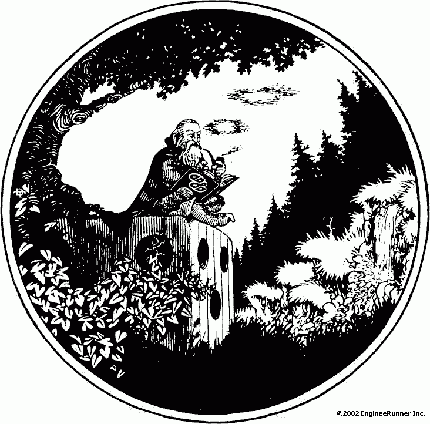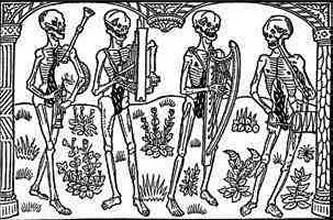 This spring I bought chickens. Chicks really, gold-barred wyandotts, Australorps, and Amber-links. They're getting big now, but not yet mature.
This spring I bought chickens. Chicks really, gold-barred wyandotts, Australorps, and Amber-links. They're getting big now, but not yet mature.I've never raised chickens before, and I thought it would be interesting. It has been.
I built a small enclosure off of one side of my garden, which is fenced in. A pair of hawks nest in a large sycamore tree nearby every year, so the Chicken Containment Facility is completely closed in with chicken wire. I also went down into the ground about a foot with heavier gauge fence to discourage diggers-under. We have foxes, raccoons, opossums, mink, coyotes and stray dogs, but I haven't lost anybody yet.
I just let the chickens have free range during the day. I give them some food in the morning, and they roam the yard around the house and forage for themselves all day. At night I shake the feed cup and they come running. Then I lead them back to the C.C.F and lock them up.
It's hysterical having a mob of chickens follow you around the yard. They have a large range of vocalizations. They beep and honk, and yodel. It's like having a horde of clown cars driven by Tusken Raiders chasing you.
They aren't very bright, but they're not as stupid as I expected either. At least where it comes to food. They're tenacious once they make a food-related association.
I have an outdoor cat whom I saved from the side of the road in a fit of short sighted benevolence. He's never allowed in because he'll spray on everything in an instant. I just call him, "Spare Cat", and remind the indoor cats that they can be replaced.
As soon as the chickens have finished their morning feed, they race for the back porch and bully Spare Cat away from his cat food. It's funny to see a cat chased off by a pack of flightless thug birds.
"Funny, " you say, " But what does this have to do with D&D?"
Just wait for it. I'm getting there.
Okay, a while ago, I was reading a thread at Dragonsfoot, or Knights&Knaves, I don't remember which now. Somebody, maybe Wheggi, put up a scan from, I believe a basic rulebook, that he'd bought used.
In it, the former owner had revised the dungeon random encounter chart with some notes of his own. He'd crossed out some of the random monsters and substituted new ones.
One of the new encounters was listed as, "Chicken."
This started a conversation about just what sort of chicken a group of adventurers might encounter in the depths of the dungeon.
Well, I'll tell you what sort of chicken.
Ladies and gentlemen, I give you the Gorecock of the Underdark. Also known as, the Dread Dungeon Chicken!
Gorecock.
Frequency: very rare
No. appearing: 6-24
Armor class: 5
Move: 16"
Hit dice: 1+2
% in lair: 50%
Treasure type: nil
No. of attacks: 3 per round
Damage/attack: 1-4/1-4/1-4
Special attacks: Crow, (Save or lose balance due to disorientation.)
Special defenses: nil
Magic resistance: standard
Intelligence: Animal, barely
Alignment: neutral evil
Size: S, (40-50lbs)
Psionic ability: nil
The learned Scholarchs of Delleb's Grand Library-Temple, who often fair forth to smite ignorance and scourge the unthinking, hold it as common wisdom that it is the will of the Gods that life take many forms. Why it is so that so many of these forms must be inimical to man, they cannot say. It seems that in Greyhawk, even the most harmless and bucolic creatures often assume forms less benign.
So it is that, deep beneath the warm and lighted surface of the Oerth, the weird and untamed thaumaturgic radiations of the Underdark have worked a strange and malignant transformation upon even the common Pasture Fowl of the surface world.
The result of this metamorphosis? The dreadful Gorecock of the Underdark.
Though the ancestors of the Gorecock may have been ordinary yard fowl, their descendants bear them only a general resemblance.
The Gorecock's heavy, black feathers have become tough and horny, giving it good protection from attack. It is armed with terrible slashing talons and spurs, as well as an atavistic, serrated beak.
When first encountered, a gorecock will leap to the attack, clawing with both feet at once, and always choosing the nearest target.
If a gorecock's first attack does damage, it will automatically continue the fight. If it should miss, or take damage itself, there is a 50% chance it will break off the attack and flee with it's hens.
If the gorecock attacks with surprise, and hits successfully, the target must save vs paralysis or stumble and fall to the ground. This is not a power of the gorecock, simply the result of being unprepared for the impact of an enraged tunnel rooster.
The gorecock does have one special attack, though it is not itself aware of it's ability. In the stone confines of the dungeon, or the caverns it inhabits, the crow of the gorecock is ear-piercing and disorienting. Those withing 20' of a gorecock when it crows must save vs breath weapon or suffer loss of balance and confusion. This results in a -3 to hit penalty for three rounds, plus spell casting or psionics will not be possible for the same amount of time.
The gorecock is not intelligent enough to use it's crow deliberately. It simply screams out of excitement. There is a 25% chance per round of combat that the gorecock will crow.
If at any time, a combatant should fall to the ground, due to injuries, or the effects of the gorecocks crow, the rest of the flock, the gorehens and chicks, will rush to attack with great speed and vigor. They will mob the injured target, and depending on it's size, it will suffer at least six attacks per round until it recovers it's feet, or the flock is driven off. Gorehens and chicks do only 1 point of damage per attack and recieve only 1 attack per round.











